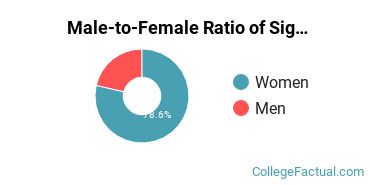 by our College Data Analytics Team
by our College Data Analytics TeamSign Language Interpretation & Translation is a concentration offered under the American Sign Language major at University of Northern Colorado. We’ve gathered data and other essential information about the master’s degree program in sign language interpretation and translation, such as diversity of students, how many students graduated in recent times, and more.
If there’s something special you’re looking for, you can use one of the links below to find it:
In 2019-2020, the average part-time graduate tuition at University of Northern Colorado was $1,090 per credit hour for out-of-state students. The average for in-state students was $604 per credit hour. Information about average full-time graduate student tuition and fees is shown in the table below.
| In State | Out of State | |
|---|---|---|
| Tuition | $10,867 | $19,620 |
| Fees | $2,088 | $2,088 |
Online degrees for the University of Northern Colorado sign language interpretation and translation master’s degree program are not available at this time. To see if the school offers distance learning options in other areas, visit the University of Northern Colorado Online Learning page.
Of the students who received their master’s degree in sign language interpretation and translation in 2019-2020, 62.5% of them were women. This is less than the nationwide number of 73.0%.

Of those graduates who received a master’s degree in sign language interpretation and translation at University of Northern Colorado in 2019-2020, 37.5% were racial-ethnic minorities*. This is higher than the nationwide number of 26%.

| Race/Ethnicity | Number of Students |
|---|---|
| Asian | 1 |
| Black or African American | 1 |
| Hispanic or Latino | 4 |
| Native American or Alaska Native | 0 |
| Native Hawaiian or Pacific Islander | 0 |
| White | 14 |
| International Students | 0 |
| Other Races/Ethnicities | 4 |
*The racial-ethnic minorities count is calculated by taking the total number of students and subtracting white students, international students, and students whose race/ethnicity was unknown. This number is then divided by the total number of students at the school to obtain the racial-ethnic minorities percentage.
More about our data sources and methodologies.